Page 409 of 714
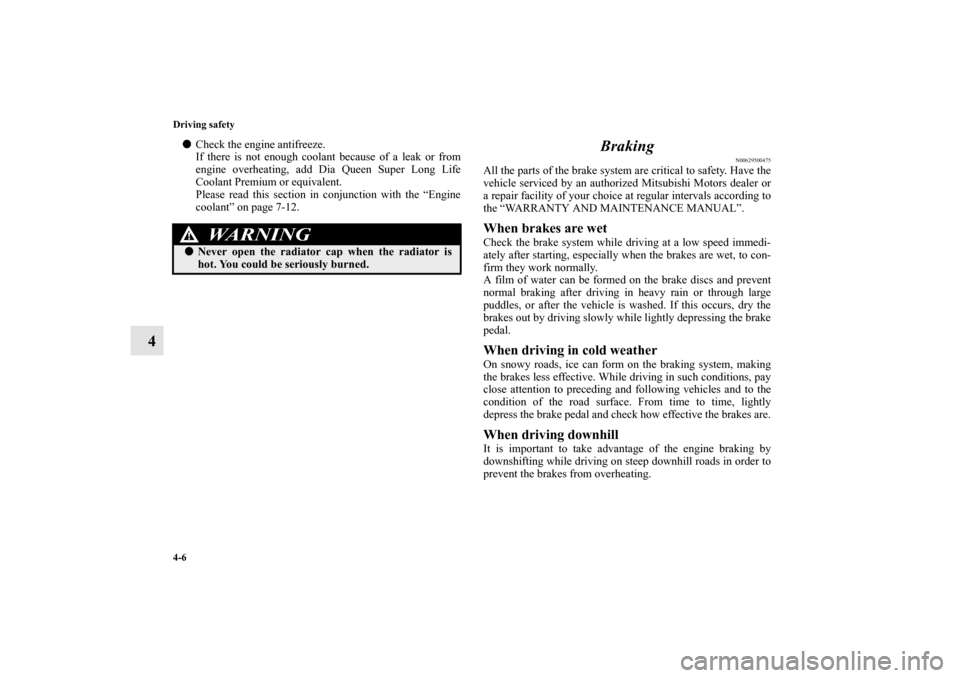
4-6 Driving safety
4
�Check the engine antifreeze.
If there is not enough coolant because of a leak or from
engine overheating, add Dia Queen Super Long Life
Coolant Premium or equivalent.
Please read this section in conjunction with the “Engine
coolant” on page 7-12.
Braking
N00629500475
All the parts of the brake system are critical to safety. Have the
vehicle serviced by an authorized Mitsubishi Motors dealer or
a repair facility of your choice at regular intervals according to
the “WARRANTY AND MAINTENANCE MANUAL”.When brakes are wetCheck the brake system while driving at a low speed immedi-
ately after starting, especially when the brakes are wet, to con-
firm they work normally.
A film of water can be formed on the brake discs and prevent
normal braking after driving in heavy rain or through large
puddles, or after the vehicle is washed. If this occurs, dry the
brakes out by driving slowly while lightly depressing the brake
pedal.When driving in cold weatherOn snowy roads, ice can form on the braking system, making
the brakes less effective. While driving in such conditions, pay
close attention to preceding and following vehicles and to the
condition of the road surface. From time to time, lightly
depress the brake pedal and check how effective the brakes are.When driving downhillIt is important to take advantage of the engine braking by
downshifting while driving on steep downhill roads in order to
prevent the brakes from overheating.
WA R N I N G
!�Never open the radiator cap when the radiator is
hot. You could be seriously burned.
BK0122500US.book 6 ページ 2010年5月12日 水曜日 午前11時11分
Page 410 of 714
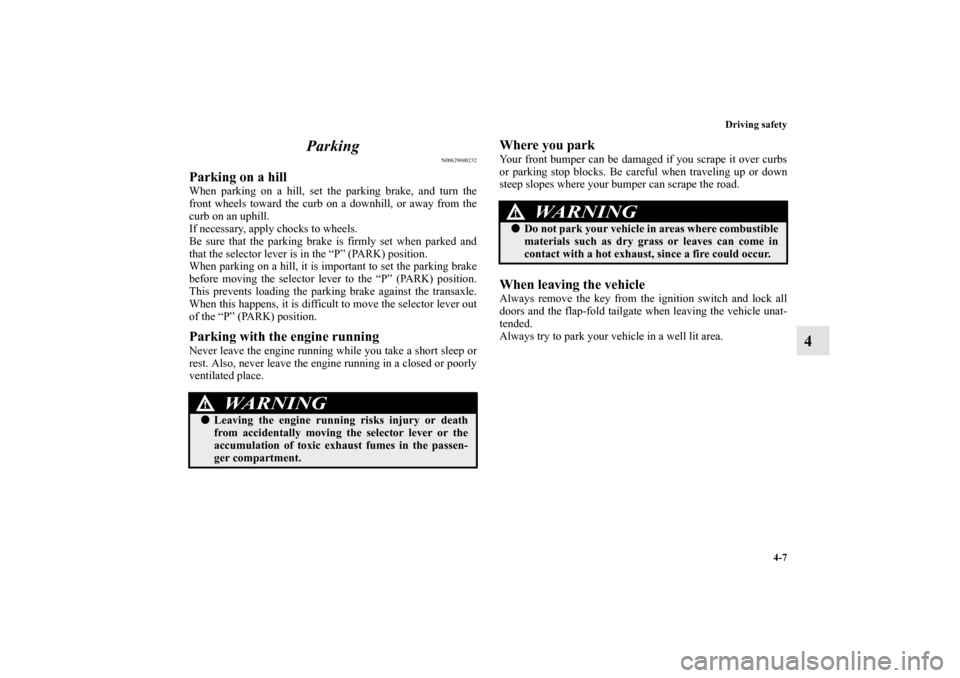
Driving safety
4-7
4 Parking
N00629600232
Parking on a hillWhen parking on a hill, set the parking brake, and turn the
front wheels toward the curb on a downhill, or away from the
curb on an uphill.
If necessary, apply chocks to wheels.
Be sure that the parking brake is firmly set when parked and
that the selector lever is in the “P” (PARK) position.
When parking on a hill, it is important to set the parking brake
before moving the selector lever to the “P” (PARK) position.
This prevents loading the parking brake against the transaxle.
When this happens, it is difficult to move the selector lever out
of the “P” (PARK) position.Parking with the engine runningNever leave the engine running while you take a short sleep or
rest. Also, never leave the engine running in a closed or poorly
ventilated place.
Where you parkYour front bumper can be damaged if you scrape it over curbs
or parking stop blocks. Be careful when traveling up or down
steep slopes where your bumper can scrape the road.When leaving the vehicleAlways remove the key from the ignition switch and lock all
doors and the flap-fold tailgate when leaving the vehicle unat-
tended.
Always try to park your vehicle in a well lit area.
WA R N I N G
!�Leaving the engine running risks injury or death
from accidentally moving the selector lever or the
accumulation of toxic exhaust fumes in the passen-
ger compartment.
WA R N I N G
!�Do not park your vehicle in areas where combustible
materials such as dry grass or leaves can come in
contact with a hot exhaust, since a fire could occur.
BK0122500US.book 7 ページ 2010年5月12日 水曜日 午前11時11分
Page 421 of 714
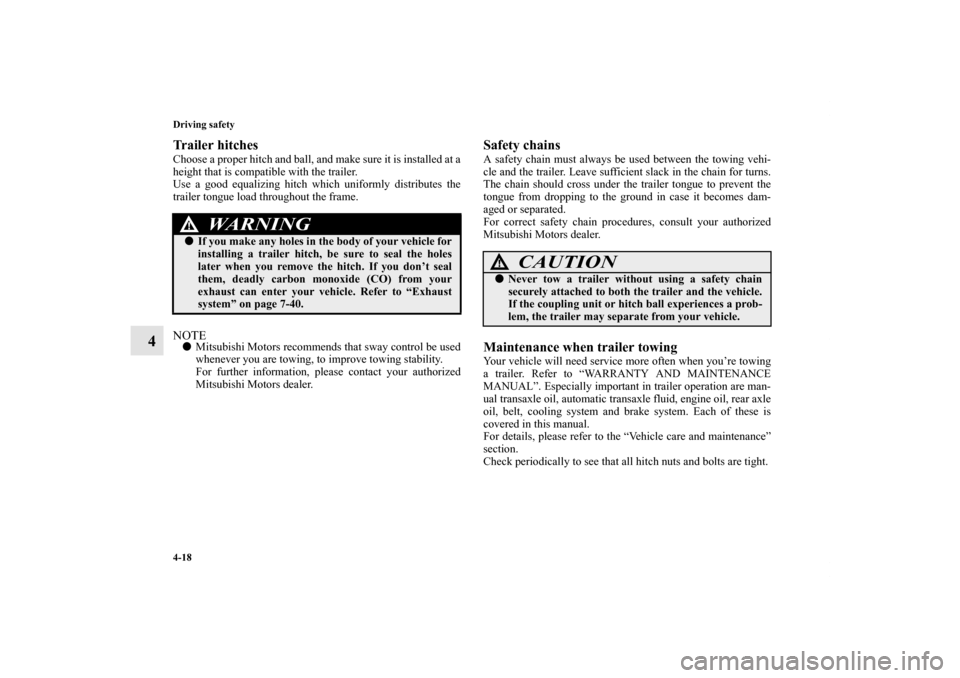
4-18 Driving safety
4
Trailer hitchesChoose a proper hitch and ball, and make sure it is installed at a
height that is compatible with the trailer.
Use a good equalizing hitch which uniformly distributes the
trailer tongue load throughout the frame.NOTE�Mitsubishi Motors recommends that sway control be used
whenever you are towing, to improve towing stability.
For further information, please contact your authorized
Mitsubishi Motors dealer.
Safety chainsA safety chain must always be used between the towing vehi-
cle and the trailer. Leave sufficient slack in the chain for turns.
The chain should cross under the trailer tongue to prevent the
tongue from dropping to the ground in case it becomes dam-
aged or separated.
For correct safety chain procedures, consult your authorized
Mitsubishi Motors dealer.Maintenance when trailer towingYour vehicle will need service more often when you’re towing
a trailer. Refer to “WARRANTY AND MAINTENANCE
MANUAL”. Especially important in trailer operation are man-
ual transaxle oil, automatic transaxle fluid, engine oil, rear axle
oil, belt, cooling system and brake system. Each of these is
covered in this manual.
For details, please refer to the “Vehicle care and maintenance”
section.
Check periodically to see that all hitch nuts and bolts are tight.
WA R N I N G
!�If you make any holes in the body of your vehicle for
installing a trailer hitch, be sure to seal the holes
later when you remove the hitch. If you don’t seal
them, deadly carbon monoxide (CO) from your
exhaust can enter your vehicle. Refer to “Exhaust
system” on page 7-40.
CAUTION
!�Never tow a trailer without using a safety chain
securely attached to both the trailer and the vehicle.
If the coupling unit or hitch ball experiences a prob-
lem, the trailer may separate from your vehicle.
BK0122500US.book 18 ページ 2010年5月12日 水曜日 午前11時11分
Page 423 of 714
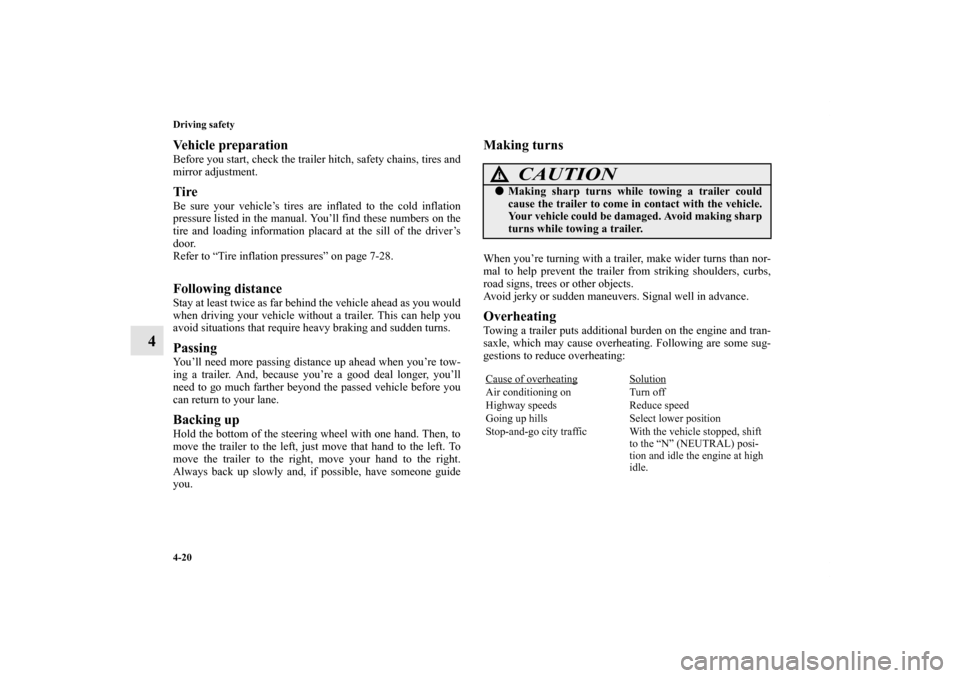
4-20 Driving safety
4
Vehicle preparationBefore you start, check the trailer hitch, safety chains, tires and
mirror adjustment.TireBe sure your vehicle’s tires are inflated to the cold inflation
pressure listed in the manual. You’ll find these numbers on the
tire and loading information placard at the sill of the driver’s
door.
Refer to “Tire inflation pressures” on page 7-28.Following distanceStay at least twice as far behind the vehicle ahead as you would
when driving your vehicle without a trailer. This can help you
avoid situations that require heavy braking and sudden turns.PassingYou’ll need more passing distance up ahead when you’re tow-
ing a trailer. And, because you’re a good deal longer, you’ll
need to go much farther beyond the passed vehicle before you
can return to your lane.Backing upHold the bottom of the steering wheel with one hand. Then, to
move the trailer to the left, just move that hand to the left. To
move the trailer to the right, move your hand to the right.
Always back up slowly and, if possible, have someone guide
you.
Making turnsWhen you’re turning with a trailer, make wider turns than nor-
mal to help prevent the trailer from striking shoulders, curbs,
road signs, trees or other objects.
Avoid jerky or sudden maneuvers. Signal well in advance.OverheatingTowing a trailer puts additional burden on the engine and tran-
saxle, which may cause overheating. Following are some sug-
gestions to reduce overheating:
CAUTION
!�Making sharp turns while towing a trailer could
cause the trailer to come in contact with the vehicle.
Your vehicle could be damaged. Avoid making sharp
turns while towing a trailer.Cause of overheating
Solution
Air conditioning on Turn off
Highway speeds Reduce speed
Going up hills Select lower position
Stop-and-go city traffic With the vehicle stopped, shift
to the “N” (NEUTRAL) posi-
tion and idle the engine at high
idle.
BK0122500US.book 20 ページ 2010年5月12日 水曜日 午前11時11分
Page 424 of 714

Driving safety
4-21
4
When towing at high altitudes, engine coolant and automatic
transaxle oil will overheat at a lower temperature than at nor-
mal altitudes.
If you turn your engine off immediately after towing at high
altitude on steep uphill grades, your vehicle may show signs
similar to overheating. To avoid this, let the engine run while
parked (preferably on level ground) with the automatic tran-
saxle in the “P” (PARK) position for a few minutes before turn-
ing the engine off.
�If the engine coolant temperature indicator flashes on
the information screen in the multi-information display or
the engine power drops suddenly, refer to “Engine over-
heating” on page 6-5.
�If the warning display or warning display illumi-
nates, refer to “Warning display” on page 3-96.Driving on hillsReduce speed and downshift before you start down a long or
steep downgrade. If you don’t shift down, over using the
brakes can cause reduced brake efficiency.
You can tow in “D” (DRIVE) position. You may want to shift
the selector lever to the 3rd or a lower position, under heavy
loads or hilly conditions.
ParkingAlways place chocks or blocks under both the vehicle and
trailer wheels when parking. Be sure that the parking brake is
firmly set and that the selector lever is in the “P” (PARK) posi-
tion. Avoid parking on a hill with a trailer, but if it cannot be
avoided, do so only after performing the following:
1. Apply the brakes and keep them applied.
2. Have someone place chocks or blocks under both the
vehicle and trailer wheels.
3. When the chocks or blocks are in place, release your
brakes slowly until the chocks or blocks absorb the load.
4. Apply the parking brake firmly.
5. Set the selector lever to the “P” (PARK) position and turn
off the engine.
BK0122500US.book 21 ページ 2010年5月12日 水曜日 午前11時11分
Page 425 of 714
4-22 Driving safety
4
When restarting out after parking on a hill:
1. Check that the selector lever is set to the “P” (PARK)
position.
2. Start the engine. Be sure to keep the brake pedal
depressed.
3. Set the selector lever to the “D” (DRIVE) position or “R”
(REVERSE) position.
4. Release the parking brake and brake pedal and slowly pull
or back away from the chocks or blocks. Stop and apply
your brakes.
5. Have someone retrieve the chocks or blocks.BK0122500US.book 22 ページ 2010年5月12日 水曜日 午前11時11分
Page 434 of 714
Comfort controls
5-7
5
Temperature control dial
N00736600189
Turn the temperature control dial clockwise to make the air
warmer. Turn it counterclockwise to make the air cooler.NOTE�While the engine coolant temperature is low, the tempera-
ture of the air from the heater will be cool/cold until the
engine warms up, even if you have selected warm air with
the dial.
�For instructions on how to use the “MAX A/C” position
(A), refer to “For quick cooling” on page5-12.
Mode selection dial
N00736700151
To change the amount of air flowing from the vents, turn the
mode selection dial. Refer to “Changing the mode selection”
on page 5-3.
BK0122500US.book 7 ページ 2010年5月12日 水曜日 午前11時11分
Page 437 of 714
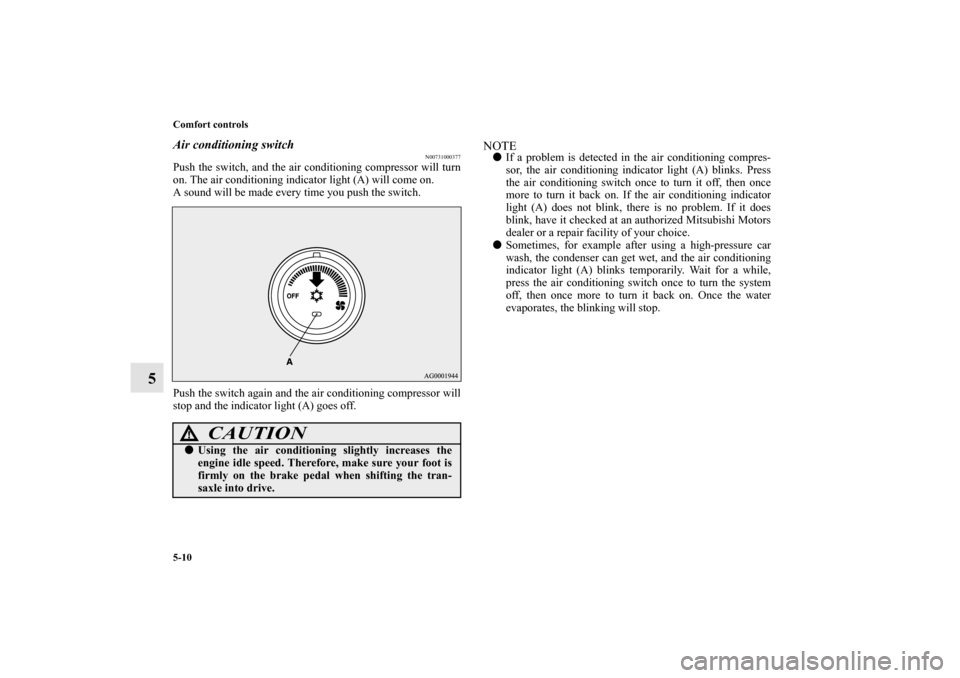
5-10 Comfort controls
5
Air conditioning switch
N00731000377
Push the switch, and the air conditioning compressor will turn
on. The air conditioning indicator light (A) will come on.
A sound will be made every time you push the switch.
Push the switch again and the air conditioning compressor will
stop and the indicator light (A) goes off.
NOTE�If a problem is detected in the air conditioning compres-
sor, the air conditioning indicator light (A) blinks. Press
the air conditioning switch once to turn it off, then once
more to turn it back on. If the air conditioning indicator
light (A) does not blink, there is no problem. If it does
blink, have it checked at an authorized Mitsubishi Motors
dealer or a repair facility of your choice.
�Sometimes, for example after using a high-pressure car
wash, the condenser can get wet, and the air conditioning
indicator light (A) blinks temporarily. Wait for a while,
press the air conditioning switch once to turn the system
off, then once more to turn it back on. Once the water
evaporates, the blinking will stop.
CAUTION
!�Using the air conditioning slightly increases the
engine idle speed. Therefore, make sure your foot is
firmly on the brake pedal when shifting the tran-
saxle into drive.
BK0122500US.book 10 ページ 2010年5月12日 水曜日 午前11時11分